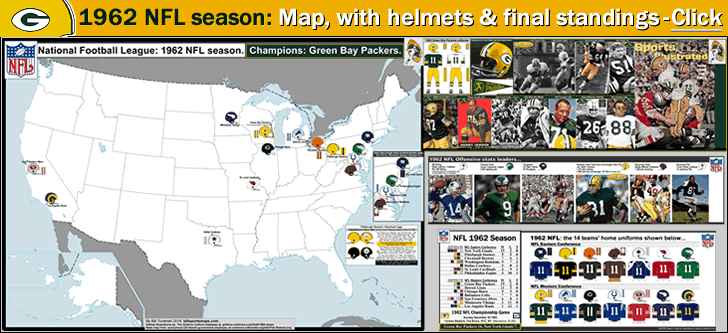
NFL 1962 season, map with helmets/jerseys & final standings + offensive stats leaders
…
…
By Bill Turianski on 30 January 2019; twitter.com/billsportsmaps.
Links…
-1962 NFL season
-1962 NFL Championship Game (en.wikipedia.org).
-1962 NFL season (pro-football-reference.com).
-1962 NFL uniforms (gridiron-uniforms.com).
…
- In 1962, the Green Bay Packers repeated as champions.
This was start of the Packers historic run of 5 NFL titles in 7 seasons (1961, 1962, 1965, 1966, 1967).
The season before, in 1961, the Green Bay Packers, under third-year head coach Vince Lombardi, had won their first NFL title in 18 years (their last title had been won in 1944). In the 1961 NFL title game, the small-town Packers had demolished the big-city New York Giants 36 to 0, at the then-4-year old City Stadium [now called Lambeau Field] in Green Bay, WI. (Population of Green Bay in 1960: 62,000 {en.wikipedia.org/wiki/Green_Bay,_Wisconsin#Demographics}.) Although the Packers had a decent new stadium, one which was capable of expansion, the fact still remained that the Green Bay NFL franchise was the last vestige of the small-town era of the NFL (1920-34).
The small-town Green Bay Packers were a team that played in a league that was becoming exponentially more popular each year. Every NFL or AFL team in 1962 played in a city that was at least 10 times larger than tiny and isolated Green Bay. Even the creation of the new rival-league the AFL, which started up in 1960 with 8 teams, had not changed that fact. (The NFL had 14 teams as of 1962, so by 1962, there were 22 major-league pro football teams in the USA.) Yet by 1962, many cities ten times the size of Green Bay still did not have an NFL or AFL team, and they were clamoring for one.
…
1962 NFL Championship Game – Green Bay Packers 16, New York Giants 7.
In 1962, both the Packers and the Giants had repeated as conference [divisional] winners. The Packers went 13-1, winning the West by 2 games and losing only to the 2nd-place-finishing Lions. The Giants went 12-2, winning the East by 3 games, with losses to the 2nd-place Steelers and to the 3rd-place Browns. The Packers’ offense, which was the league’s best in ’62 (at 29.6 points per game) was built on a strong ground game. The Packers starting QB was Bart Starr, and they were led offensively by FB Jim Taylor, and HB/K Paul Hornung, but Hornung was partially injured in 1962. Jim Taylor led the league in rushing yards, yards from scrimmage, and TDs, and was voted the NFL’s MVP in 1962. The Packers’ main receiving threat was WR/P Max McGee, and TE Ron Kramer was an All-Pro in ’62. The Packers’ defense was best in the league as well, allowing just 10.5 points per game. There were 5 All-Pros in the 1962 Packers’ D: linemen Willie Davis and Henry Jordan, LBs Bill Forester and Dan Currie, and CB/KR Herb Adderley. The Giants were almost as high-scoring as the Packers (at 28. 4 ppg). The Giants were led at QB by former 49er YA Tittle, and Tittle led the NFL in TD passes in 1962. Tittle’s main targets were End Del Shofner, HB Frank Gifford, and TE Joe Walton. The Giants were coached by Allie Sherman, who was in his second season.
Due to the rotating home-field-advantage rule in the NFL back then, it was the Eastern Conference’s turn to host the NFL title game, so that meant the New York Giants would be playing the Packers at Yankee Stadium in The Bronx, NY, on Sunday, December 30, 1962. (It was the 3rd time in 7 years that Yankee Stadium hosted the NFL title game [previously in 1956 and 1958].) Green Bay was favored by 6½ points.
(Yankee Stadium was where the Brooklyn-born Vince Lombardi, former Offensive coach of the Giants (from 1954-58), had first established his pro football coaching credentials. That is why the Packers-at-Giants 1962 NFL title game was so important to Lombardi.)
The game was played under severely cold conditions: temperature was 17 °F (−8 °C), with 35 mph winds. The conditions made throwing the ball difficult.
The game was a hard-fought and low-scoring affair. Although the NY Giants slightly out-gained the Packers, Green Bay caused 3 turnovers (2 fumbles and one interception). Packers MLB Ray Nitschke (#66) recovered both fumbles, and Nitschke also had a pass deflection which caused the interception. Nitschke was selected as MVP of the game. Packers FB Jim Taylor (#31) ran for 85 yards, plus he gained 20 yards receiving, and Taylor scored the Packers’ only TD. The Packers defense did not allow New York to score on them (the Giants’ TD was scored by their special teams, off a blocked punt in the 3rd quarter).
The Packers’ Guard Jerry Kramer (#64) was also their replacement Kicker in 1962. (Kramer replaced partially-injured HB/K Paul Hornung.) In the 1962 NFL title game, Jerry Kramer’s kicking game proved to be the difference, as he converted all 3 of his FG attempts (of 26, 29, and 30 yards). Those 3 Field Goals were no chip-shots, due to the 35-40 mph winds. Here is an article, {Packers vs. Giants in the 1962 NFL Championship Game: Jerry Kramer Does It All, by Bob Fox at bleacherreport.com from Nov. 2011.} (Jerry Kramer was voted into the Pro Football Hall of Fame by the Seniors Committee, in 2018.)
With Green Bay beating the Giants in the 1962 title game, the Packers had just made straight 3 NFL title-game appearances, winning two of them. But the New York Giants had just made 4 NFL title-game appearances in 5 years…and they had lost all 4 times (losing to Baltimore in 1958 and ’59, and losing to Green Bay in 1961 and ’62). And the Giants would lose, again, in the title-game the following season (losing to the Bears, in 1963).

Photo and Image credits above -
Packers 1962 and NY Giants 1962 helmets, illustrations by gridiron-uniforms.com/[1962]. Vince Lombardi on the sidelines at Yankee Stadium, photo by Neil Leifer at neilleifer.com. Nitschke stopping Giants’ Alex Webster, photo by Neil Leifer at neilleifer.com. Nitschke recovering fumble, photo by Milwaukee Journal-Sentinel at archive.jsonline.com. Ray Nitschke, photo unattributed at cmgww.com/football/nitschke. . Jim Taylor scoring in 1962 NFL title game, photo by Vernon Biever via nydailynews.com/sports. Jerry Kramer, photo by Frank Rippon via packers.com. Jerry Kramer kicking a FG in 1962 title game, photo unattributed at fs64sports.blogspot.com. Packers congratulating Kramer after his 4th quarter FG, screenshot of video from nfl.com/videos.
1962 Green Bay Packers: 10 All-Pro players; plus 10 from the ’62 Packers were later inducted into the Pro Football Hall of Fame.
Note: All-Pro, below, means: 1962 AP, 1st team.
-Jim Taylor (FB): 1962 All-Pro, and 1962 MVP [AP]; Taylor was inducted to the HoF in 1976.
-Forrest Gregg: 1962 All-Pro (T); Gregg was inducted into the HoF in 1977.
-Herb Adderley: 1962 All-Pro (CB/KR); Adderley was inducted into the HoF in 1980.
-Willie Davis: 1962 All-Pro (DE); Davis was inducted into the HoF in 1981.
-Jim Ringo: 1962 All-Pro (C); Ringo was inducted to the HoF in 1981.
-Jerry Kramer: 1962 All-Pro (G/K); Kramer was inducted to the HoF in 2018.
-Dan Currie: 1962 All-Pro (LB).
-Bill Forester: 1962 All-Pro (LB).
-Henry Jordan: 1962 All-Pro (DT).
-Ron Kramer: 1962 All-Pro (TE).
-Bart Starr (QB); Starr was inducted into the HoF in 1977.
-Ray Nitschke (LB); Nitschke was inducted into the HoF in 1981.
-Paul Hornung (HB/K); Hornung was inducted to the HoF in 1986.
-Vince Lombardi (Head coach of the Packers from 1959-67). Lombardi was inducted into the HoF in 1971.
…
- Helmet changes in 1962 NFL: Bears, 49ers, and Steelers introduce helmet logos (see further below).
The chart below shows NFL teams’ helmet-logos and changes in design, in a 10-year span (1953 to 1962 seasons). This was the time period that saw the most drastic changes in helmet logo design in the NFL. By 1962, the iconography of NFL teams had been set. And with very few exceptions, the helmet logo-designs of each of the 14 NFL teams of 1962 have not changed much at all to this day…only Washington’s helmet is different today, while the Cowboys and the 49ers changed helmet colors [both did so in 1964]).
Below: NFL teams 1953 to 1962: Helmet logo-design changes (10-season-span)
NFL teams (franchises) listed in order of establishment. Helmet-logo-changes are indicated by an arrow, with date shown.
Click on image below for full-size chart…
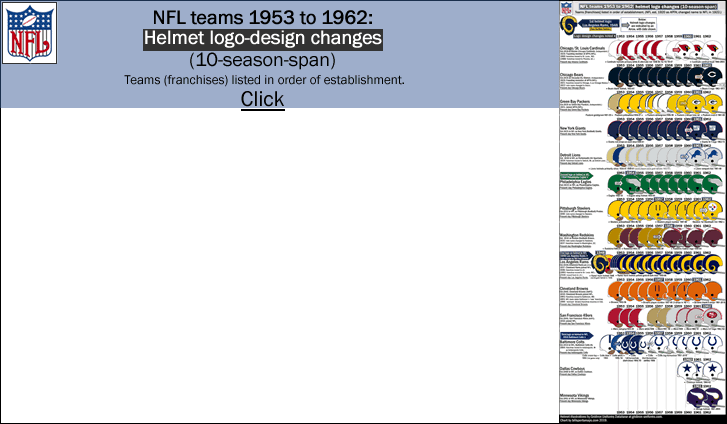
NFL teams 1953 to 1962: Helmet logo-design changes (10-season-span)
Helmet illustrations from gridiron-uniforms.com.
…
1962: Chicago Bears introduce their helmet-logo (a wishbone-shaped-C), on their midnight blue helmet.
Below: Chicago Bears’ helmet evolution (since the post-War era/1946-2018)…
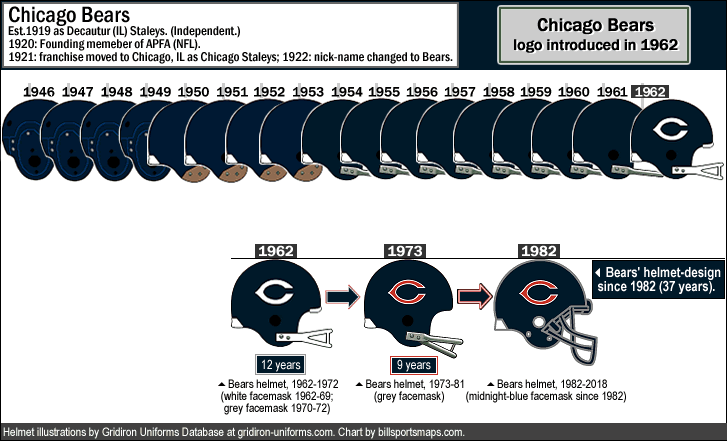
Bears helmets from gridiron-uniforms.com/[CHI].
…
1962: San Francisco 49ers introduce their helmet-logo (S-F-in-football), on a silver helmet.
(Two years later, in 1964, the 49ers would introduce their S-F-in-football logo, on a gold helmet.)
Below: San Francisco 49ers’ helmet evolution (since their inception in the AAFC in 1946/1946-2018)…
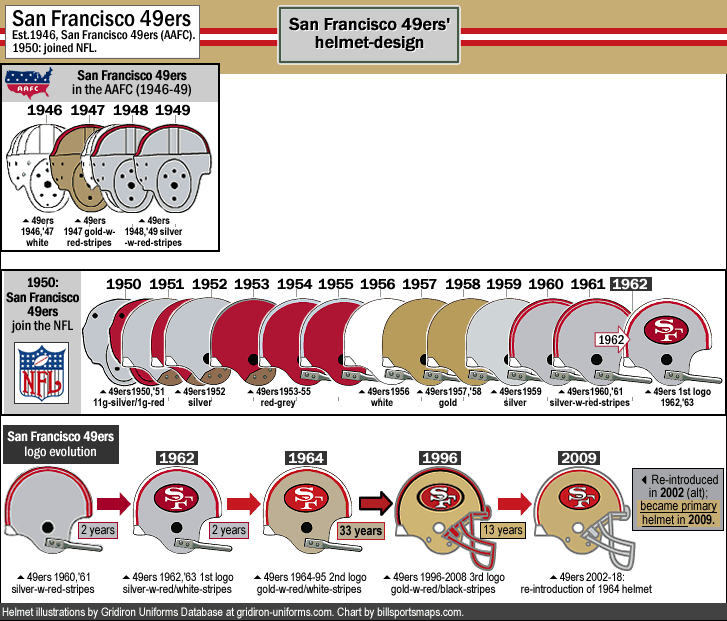
49ers helmets from gridiron-uniforms.com/[SF].
…
1962: the Pittsburgh Steelers introduce their helmet-logo (the US Steel Steelmark), on their gold helmet.
(One year later, in 1963: the Steelers would introduce their revised Steelmark logo, on a black helmet.)

Photo and Image credits above – researchgate.net.
In January of 1960, the U.S. Steel Corp. introduced the Steelmark logo. The original Steelmark logo was a grey-edged circle enclosing three hypocycloids (diamonds with inward-curving edges) with the word ‘Steel’; the three star-shapes were in yellow, orange and blue. It was used to promote the steel industry, both in print ads and on labels on the steel products themselves. Throughout the Sixties and the Seventies the Steelmark logo was on labels of American-made steel products ranging from kitchenware to filing cabinets to steel tanks to tricycles. In 1962, Republic Steel of Cleveland, a co-owner of the Steelmark logo, approached the Pittsburgh Steelers organization about using the Steelmark logo in their football uniforms. The Steelers debuted the Steelmark logo on their gold helmets in the 10th week of the 1962 NFL season, on Sunday the 18th of November (the Steelers beat Washington 32-21 that day).
So the Pittsburgh Steelers new helmet-logo, with their first version of the Steelmark logo, was worn for the last 5 games in 1962. The orange star from one of the the original designs was replaced with a red star (making the 3 stars Yellow, Red, and Blue). The logo was worn on only the right side of the gold 1962 Steelers helmet. The reason for this was because the team was not sure the look would be popular. So the equipment manager of the Steelers was instructed to affix the Steelmark logo-decals to only the right-side of the helmets, in case the helmets didn’t look good (so that there would be less work scraping them off, if they didn’t look OK). Well, they looked fine.
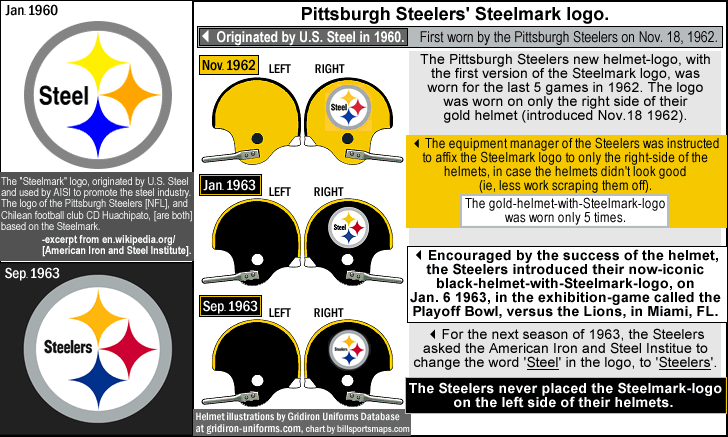
Steelers helmets from gridiron-uniforms.com/[PIT].
Encouraged by the success of the Steelmark-logo helmet, the Steelers decided to try it out on a black helmet. And so 8 weeks later, the Steelers introduced their now-iconic black-helmet-with-Steelmark-logo, on Jan. 6 1963, in the exhibition-game called the Playoff Bowl, versus the Lions, in Miami, FL. The helmet was simply a reverse of their existing helmet: black-with-a-gold-stripe instead of gold-with-a-black-stripe.
For the next season of 1963, the Steelers petitioned the Steelmark logo’s owner, the American Iron and Steel Institute, to let the football team change the word ‘Steel’ in the logo to ‘Steelers’. Also, the outside grey circle on the logo was made a lighter grey, and was a wider ring. The Steelers added small white player-numbers to the front of the helmet (the team had worn large player-numbers on the sides of their helmets from 1957-61/ see helmet-logos chart further above to see that).
The Steelers never placed the Steelmark-logo on the left side of their helmets. The Steelers have worn this helmet design since September 1963. The only changes made have been…1) the Steelers changed from grey facemasks to black facemasks, in 1977; and 2) they made the blue star a tiny bit darker, in 2002 {sportslogos.net/Pittsburgh_Steelers}.
___
Photo and Image credits
Packers players on map page,
Reproduction of early-1960s Packers helmet, from ebay.com. Early-1960s Packers pennant, from sports.mearsonlineauctions.com. Bart Starr & Jim Taylor, photo by George Silk/Getty Images via gettyimages.com. Jerry Kramer [photo circa 1963], unattributed at pinterest.com. Jim Ringo [photo circa 1962], unattributed at thegridfe.com. Jim Taylor & Forrest Gregg [SI cover from Sept. 1962], from si.com/vault. Willie Davis [photo circa 1964], photo unattributed at pinterest.com. Henry Jordan [1961 Topps card], from ebay.com. Dan Currie [photo circa 1963], photo unattributed at fs64sports.blogspot.com. Ray Nitschke, photo by Sports Illustrated via lombardiave.com. Bill Forester [1962 Topps card], unattributed at pinterest.com. Herb Adderley [photo circa 1962], photo unattributed at pinterest.com. Ron Kramer [photo circa 1963], unattributed at pinterest.com.
…
Offensive stats leaders on map page,
Eddie LeBaron [photo from 1961], photo by Neil Leifer via gettyimages.com. Sonny Jurgensen [photo from 1963], photo by Neil Leifer via gettyimages.ae. YA Tittle [photo from 1961], photo by Neil Leifer via si.com/vault. Jim Taylor [photo circa 1965], photo by Getty Images via 247sports.com. Bobby Mitchell [photo circa 1962], unattributed at pinterest.com. Frank Clarke [1962 Post card], from amazon.com.
…
-Blank map by anonymous US federal government employee, at File:StatesU.svg (commons.wikimedia.org).
-Thanks to the contributors at pro-football-reference.com
-Thanks to the contributors at NFL 1962 season (en.wikipedia.org).
Special thanks to Tim Brulia, Bill Schaefer and Rob Holecko of The Gridiron Uniform Database, for giving billsportsmaps.com the permission to use football uniforms illustrations from Gridiron Uniform Database {GUD}.
